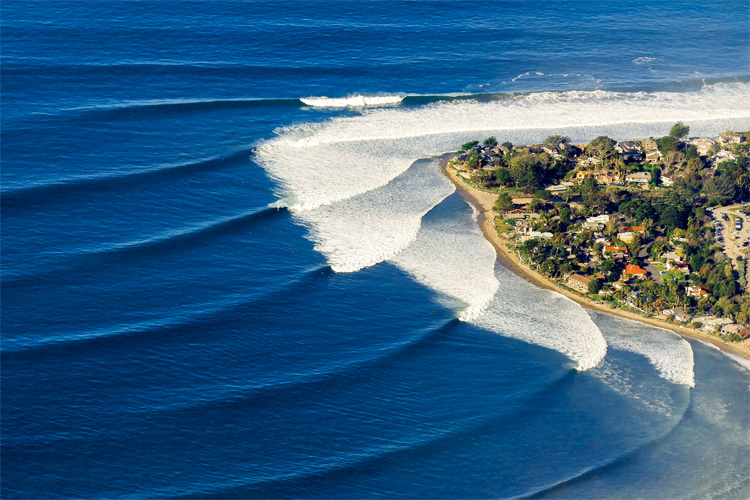Nestled on the border between Ventura and Santa Barbara counties in Southern California, Rincon Point, or "Queen of the Coast," is heralded as one of America's prime surfing destinations.
Renowned for its grace, elegance, and hypnotic waves, Rincon offers an unparalleled surfing experience.
It's the winter counterpart to Malibu Surfrider Beach.
Tom Morey, the legendary father of modern bodyboarding, once called it "the best surf in the United States."
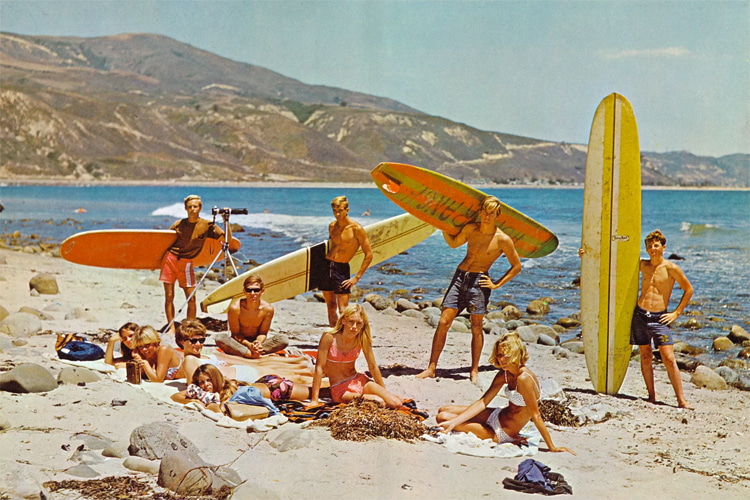
The Distinctive Corner
A unique confluence of geological conditions has bestowed Rincon with its distinct character.
Sculpted by the relentless flow of Rincon Creek from the Santa Ynez Mountains to the sea, the natural point at Rincon has been shaped over millennia into a remarkable delta.
The swells from the north engage with the land, gracefully wrapping around the point to find their way into a cove.
With the beaches of Rincon orienting towards the south, westerly winds sweep sideways across the waves, a motion that holds them from flattening, preserving their tantalizing form.
Actually, the Spanish word "Rincon" means "corner," which explains everything.
Adding to the mystique, Rincon's rocky ocean floor contributes to crafting the much-coveted cylindrical waves that have enchanted surfers for generations.
The famed surf break bears an additional geographical allure: its position straddling the boundary between Ventura and Santa Barbara counties.
This unique feature offers the thrilling possibility of embarking on a ride in Santa Barbara County only to arrive in Ventura, providing that the waves are generous and fellow surfers respectful of your path.
It's a curious quirk that only adds to the mystique of this legendary surf spot, the "Queen of the Coast."
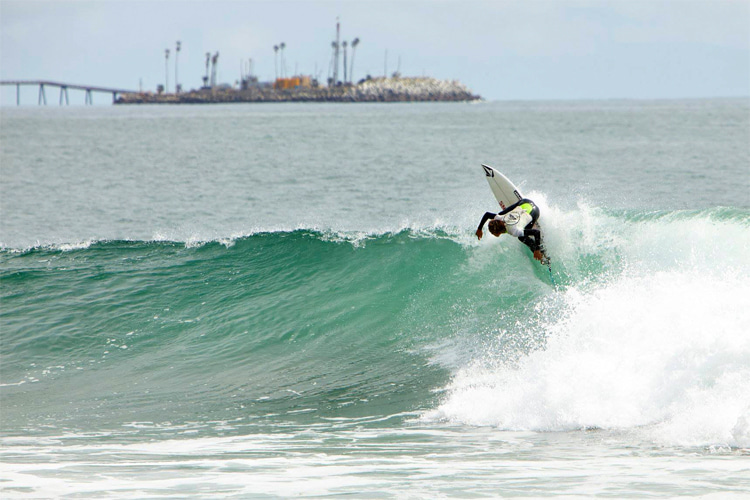
The History of the Surf Break
The history of Rincon Point stretches back to the late 1930s when Santa Barbara County lifeguard Gates Foss was credited as the first to surf the break.
Initially known as "Three Mile" due to its location three miles below the town of Carpinteria, the area gained popularity after World War II.
Surfing Royalty
Over the years, Rincon attracted top Malibu surfers, including Bob Simmons, Joe Quigg, Mickey Dora, Lance Carson, and Kemp Aaberg.
Some, like Quigg, even found inspiration for new surfboard designs from their experiences at Rincon.
In the 1960s, local surfers like Renolds Yater began to develop the Santa Barbara point-surf style.
The period also saw the emergence of influential surfers like proto-hippie Bob Cooper and knee rider George Greenough.
Influences and Recognition
Rincon Point was pivotal in the late-1960s shortboard revolution and even attracted the Australian surf legend Bob McTavish.
Future world champions like Tom Curren and Kim Mearig began their journey here in the mid-1970s.
Rincon's reputation grew further when it was included in Surfing magazine's 1981 list of the "Ten Best Waves in the World" and later polled at #19 in Surfer magazine's "100 Best Waves in the World."
In the book "Rincon Point" by Vincent Burns and Stephen Bates, you'll get to know a bit more about the area's ancient history, from the Chumash village called Shuku to the 19th-century Rancho El Rincon.
You can witness the Queen of the Coast shine in all its glory in the movies "Surf Crazy" (1959), "Inside Out" (1965), "Pacific Vibrations" (1970), "Fluid Drive" (1974), "Amazing Surf Stories" (1986), "Powerglide" (1995), "Super Slide" (1999), and "One California Day" (2007).
You can learn more about these flicks in SurferToday's Surf Movies corner.
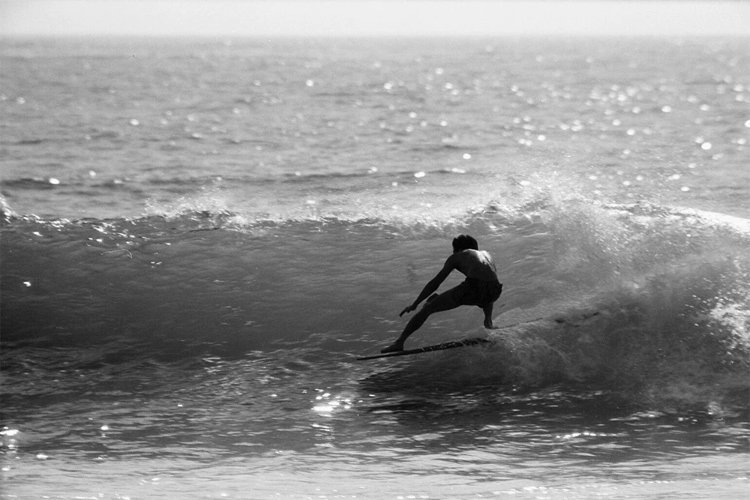
The Prestigious Rincon Classic
The Rincon Classic is an iconic and historic surfing competition that embodies the spirit and culture of Rincón Point.
Started in 1979 as an impromptu gathering of local surfers, the surf contest has since grown into a prestigious event that attracts participants and spectators from far and wide.
Its roots are deeply tied to the community, as it was initially hosted to bring friends together to surf the famed surf break.
Throughout its history, the Rincon Classic has maintained a focus on camaraderie, sportsmanship, and connection to the ocean.
After a hibernation period from 1996 to 2001, the surf contest was revived by Chris Keet and Santa Barbara's Surf Happens surf school.
The competition has various divisions, ranging from professional surfers to legends of the sport, groms, and longboarders.
The Classic is unique in that it has a flexible schedule to ensure it's held on the best weekend of waves during the holding period.
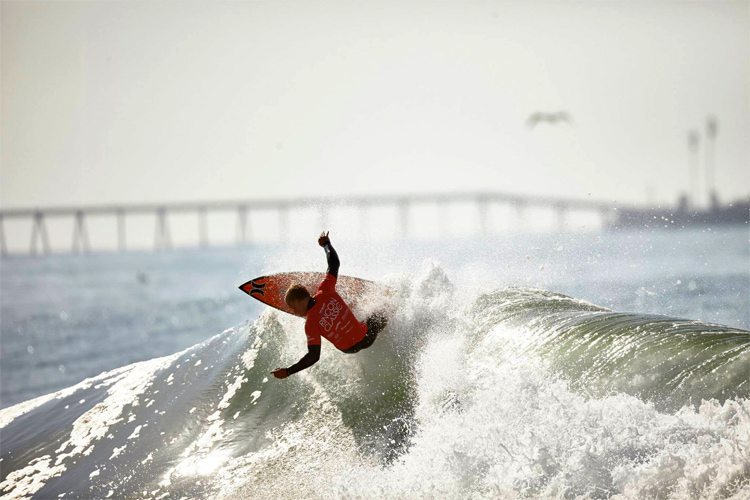
Why It Is a Great Wave to Surf
Rincon's mystique lies in its three overlapping sections:
- Indicator: Bigger and thicker, running for 75 yards before hitting Rincon Creek's river mouth;
- The Rivermouth or Second Point: Slightly smaller, breaking for about 50 yards;
- The Cove: Premier break, running up to 300 yards, perfectly tapered, and nearly hypnotic;
As surf journalist Bill Cleary wrote in 1966, "At times the wave is so close to perfection, that maneuvering... seems inappropriate, an insult to the dignity of the wave."
At Rincon, you can occasionally ride a 500-year-long wave, connecting all three peaks from Indicator to The Cove.
Crowded since the early 1960s, Rincon can see as many as 200 surfers on a good day.
Beginning in the mid-1980s, a change swept through the Southland surfing community with the advent of 976 telephone services, providing real-time surf information.
This innovation eliminated the need for surfers to traverse the 60- or 70-mile journey from Los Angeles to Rincon, hoping to find suitable waves.
Instead, surfers could now determine in advance if Rincon was primed for surfing.
According to locals, this convenience led to a marked surge in crowds, sparking outrage among local surfers who viewed the influx from L.A. as an intrusion.
The discontent prompted the 976 services to obscure Rincon's name, referring to it only as part of the "Ventura area."
Despite the doubling of crowds and sentiments that these services have "ruined" Rincon, most surfers express understanding.
They recognize the irresistible lure of Rincon's six-foot, glassy waves, admitting that they, too, would make the drive if they were on the other side.
The introduction of the 976 services first and then surf cameras and online surf reports, in essence, have reshaped the surf culture at Rincon, a reflection of both the surf spot's magnetism and the relentless march of modernity.
Issues like sewage runoff, leading to high fecal bacteria counts, have been a concern, but these do not deter the ardent fans of this beloved surf spot.
Ideal Swell and Wind Conditions
Rincon Point is a surfer's paradise thanks partly to its highly favorable swell and wind conditions.
The area thrives during the west and northwest swell season, which typically spans from late fall to early spring.
Swell
Rincon's waves are best formed with swells from the west and northwest, ranging from four to eight feet.
Swells up to 12 feet can occur, but waves of this size are often stormy or weather-beaten.
- Indicator: The top section loves a swell from the west-northwest, creating waves that run for 75 yards;
- Rivermouth: This mid-point is marginally smaller but highly responsive to the same swell direction;
- The Cove: Being in the lee of the point, the Cove offers the most celebrated break, with its wave running up to 300 yards, especially during a solid west swell;
Tide plays a significant role as well. All three breaks at Rincon improve as the tide drops, and tube sections often appear at low tide.
Wind
Offshore winds are favored at Rincon, as they groom the wave faces and allow the swells to wrap cleanly around the point.
The ideal wind conditions are from the east and northeast. Avoiding onshore winds from the west will lead to the best surfing experience.
